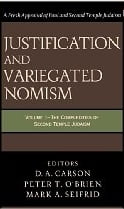
Sanders himself recognized some degree of diversity within the Second Temple literature (e.g., 4 Ezra; see Carson, O’Brien, and Seifrid 427–28). Rather than affirming the essential content of Sanders’ thesis, however, the essays in Justification and Variegated Nomism’s first volume (The Complexities of Second Temple Judaism) advocate that
[T]he literature of Second Temple Judaism reflects patterns of belief and religion too diverse to subsume under one label. . . . [At the same time, i]t is not that the new perspective has not taught us anything helpful or enduring. Rather, the straitjacket imposed on the apostle Paul by appealing to a highly unified vision of what the first-century ‘pattern of religion’ was like will begin to find itself unbuckled” (Carson, O’Brien, and Seifrid 5).2
1 To be sure, others have articulated similar positions, but Sanders’ work has provided the flashpoint for recent development in this area of Pauline scholarship. As an illustration of this prominence, Second Temple Judaism addresses Sanders most directly, by comparison, scarcely mentioning other scholars who, like W. D. Davies, have articulated similar readings of Judaism, or who, like James Dunn and N. T. Wright, have articulated their own (slightly different) versions of the implications that Sander’s reconstruction has for Pauline interpretation (cf. Carson, O’Brien, and Seifrid 4–5).
2 Similarly, Sanders says, “If we ask what the doctrine of why Israel was elect was [in the Tannaitic literature], we get no clear answer. It is clear throughout that there is a universal conviction that Israel was elect and that election entailed commandments” (Sanders 99).
In this post:
  |
Leave a Reply